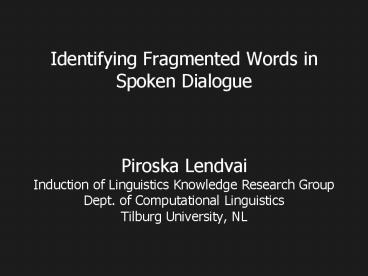Identifying Fragmented Words in Spoken Dialogue PowerPoint PPT Presentation
1 / 17
Title: Identifying Fragmented Words in Spoken Dialogue
1
Identifying Fragmented Words in Spoken Dialogue
- Piroska Lendvai
- Induction of Linguistics Knowledge Research Group
- Dept. of Computational Linguistics
- Tilburg University, NL
2
Outline
- Incomplete words pose problems to NLP
- Spoken Dutch Corpus
- Task classify each lexical item in sentence as
in/completely uttered word - Memory-based vs Rule inducing learner
- Extensive optimization strategy to
- find optimal parameter settings
- select informative features
- Findings
3
Introduction
- Spoken input contains disfluent speech
- Disfluent speech involves fragmented words
- he did not c-- call
- the safe usage of interne-- sorry of electronic
commerce - Presence of fragment is often incorporated into
NLP tools taken for granted, but - Automatic identification of a fragment cannot be
straightforwardly done - 1-letter?
- not in Lexicon?
- may be identical to existing word
4
Data
- Spoken Dutch Corpus, 203 transcribed discourses
- Various genres, 1-7 speakers
- 40,840 lexical tokens
- 44,939 sentences
- 3,137 tagged fragmented words (0.9)
- Instance generation automatically extract
feature values binary class
5
Cues in learning incomplete words
- Vector of 22 features based on corpus and the
literature - Readily available, word-based cues
- Lexical window neighbouring 2 unigram words
left/right focus word (string) - Overlap in letters/matching words (binary)
- Sentence-based general (numeric)
- Context-type (binary)
6
22 features
7
Feature vector
8
Learning process
- Memory-based lazy learner IB1 in TiMBL
- Rule inducing eager learner RIPPER
- Discourse-based partitioning 10-fold CV
- Optimization with iterative deepening on training
data - Optimal learner per fold classifies held-out test
data
9
Task baselines
- In-lexicon baseline
- 1-letter baseline
- Evaluative measures Accuracy, Precision, Recall,
Fß1 - Accuracy Prec Rec Fß1
- In-lexicon 91.4 2.4 53.6 4.6
- 1-letter 97.4 54.3 43.9 48.5
10
Optimization by iterative deepening
- Construct large number of different learners by
- varying algorithm parameters
- Varying employed feature groups
- Iterate
- Learners trained on a portion of 90 training set
- Tested on data elsewhere from 90 training set
- Ranked on F-score of Fragment class
- Good learners are re-trained on more data
11
Optimizing IB1
- 4,301 learning experiments
- Algorithm settings tested
- Number of NNs used for extrapolating the class
1 - Distance weighting metric of NNs -
- Feature importance metric ?2
- Metric for computing instance similarity
overlap - Frequency threshold in feature similarity metric
- - Data variedly represented by all possible
combinations of feature groups use all groups
12
Optimizing RIPPER
- 3,187 learning experiments
- Algorithm settings tested
- Negative tests on the feature attributes
dis/allowed - Number of optimization rounds on ruleset 3
- Amount of examples to be minimally covered 1
- Simplification/complication of hypotheses
complicate - Loss ratio of costs 0.5
- Allowed to add redundant features -
13
Results of default vs optimized learners
14
Results
15
Error analysis
- Frequent false negatives fragmented item that
resembles true word - False positives short true lexical items
- Named entities, foreign words, acronyms cause
confusion - Annotation errors
16
Discussion
- Readily available, word-based features
- Context, letter overlap, word identity reliable
- Iterative deepening search method beneficial
optimal settings uniformly differ from defaults - Example-based learning approach more successful
than abstract rule induction - RIPPER overfits on non-total data, IB1 not
- Beneficial instance-specific behaviour observed
(lt100 rules, 1-7 conditions)
17
Future Work
- Use ASR lexical output
- Generate syntactic info from ASR output
- Extract prosodic properties
- Extend research to other disfluency types

